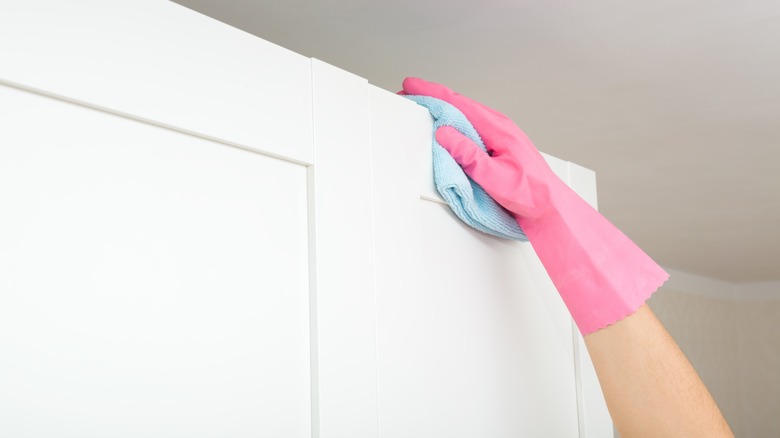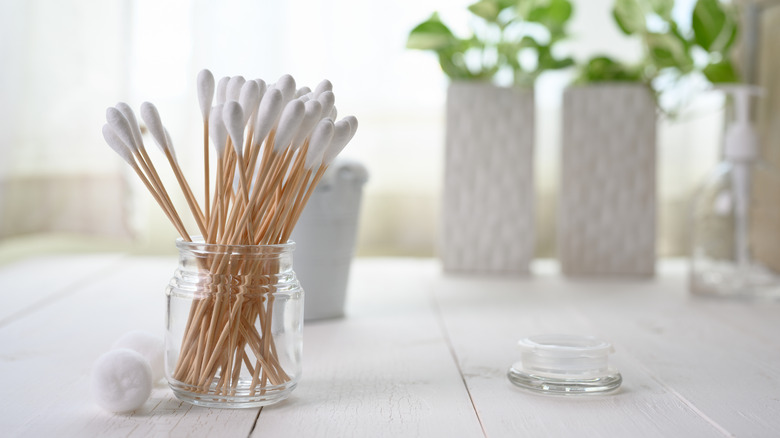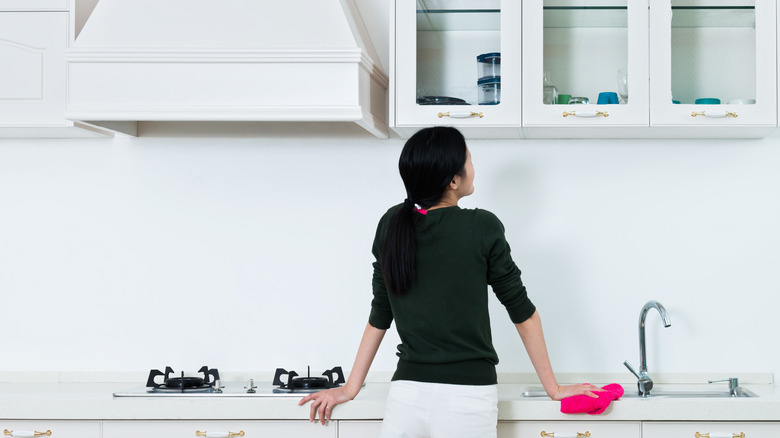The Bathroom Product You Can Use To Clean Hard-To-Reach Cabinet Molding
Traditional raised-panel, Craftsman, and shaker-style cabinets are easily recognizable by their cabinet molding on and around the doors. Cabinet molding is a design element that makes any kitchen or bathroom look more finished, warm, and elegant, but that's only when they're clean! The downside to having molding on your cabinets is that it tends to become a magnet for dirt, dust, grime, and stray splatters. When gunk builds up over a series of weeks or months, it can become notoriously difficult to clean completely. Even after you've sprayed and wiped your cabinets, sometimes they can look worse because dirt pools and accumulates in the edges of the molding, where it escapes the grip of standard cleaning rags. What can you use to get the grime out of your lovely cabinet molding? The humble cotton swab is your solution to cleaning dust from all those tricky cabinet molding crevices!
Cotton swabs are the perfect size and shape for reaching around cabinet molding and deep into corners, especially in grease-ridden areas like above the stove range. Plus, swabs are literally designed to collect and trap dirt between their cotton fibers. Here's the best way to use cotton swabs to clean your cabinet molding.
Swab away sticky corners
In most cases, a general all-purpose cleaner spray is all you need to clean your kitchen and bathroom cabinets. You can buy a pre-mixed cleaner or make your own by diluting dish soap or white vinegar with hot water. Lightly mist your cabinets with the cleaner and let the solution work its magic for a few seconds before wiping away the muck with a rag or microfiber towel. Sometimes, however, gunk can still settle in the corners and seams of your cabinet molding, where it's hard to reach, but that's where your handy cotton swabs come in!
Just like how you might use rubbing alcohol and cotton swabs to clean your ears (although you really shouldn't), you can also use an alcohol solution to clean up grease from your kitchen cabinets! Mix 7 tablespoons of distilled white vinegar with one tablespoon of rubbing alcohol and add a few drops of dish soap. Dip the tip of your cotton swab in the cleaning solution and swipe along corners and seams to instantly lift grease and dust. For really stuck-on spots, apply a bit of pressure and twist the cotton swab with your fingers so it scrubs away gunk.
Maintaining cabinet molding and other tips for Q-Tips
As is so often the case when it comes to household maintenance, prevention and regular mess upkeep are the best methods for ensuring your home stays clean. Wiping your kitchen cabinets as part of a weekly cleaning schedule will keep them looking bright and fresh and prevent buildup in the edges of the molding. You can also apply furniture wax to your cabinets to create a protective barrier and prevent water damage and dust buildup. This is especially helpful for unpainted or stained wood cabinets.
Cotton swabs are truly an underrated cleaning tool. In addition to kitchen molding, you can also use cotton swabs to clean the inside of drawers, silverware organizers, bathroom organizers, and even tricky appliances like toasters and coffee pots. Next time you clean out your car, bring a few cotton swabs to detail the interior and get pesky crumbs out of the cupholders. To speed up your cleaning routine even more, keep a bundle of cotton swaps under the kitchen sink, in your utility room, or in your cleaning caddy.


